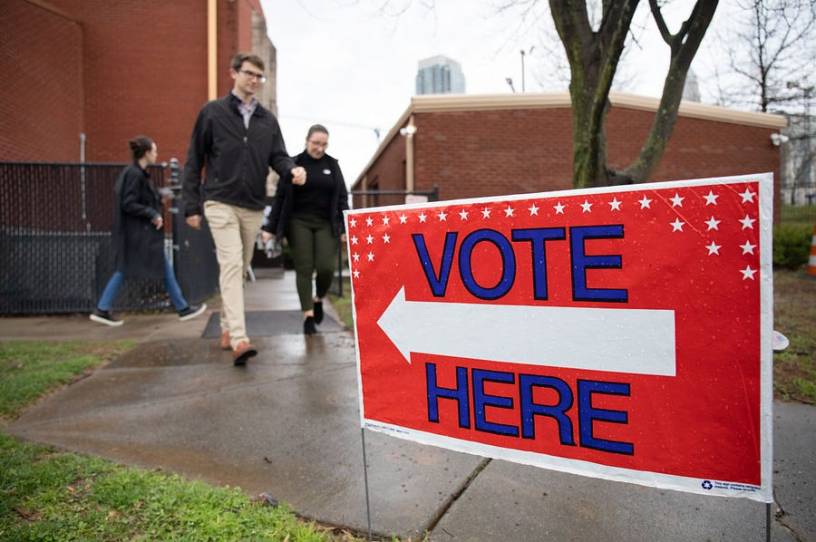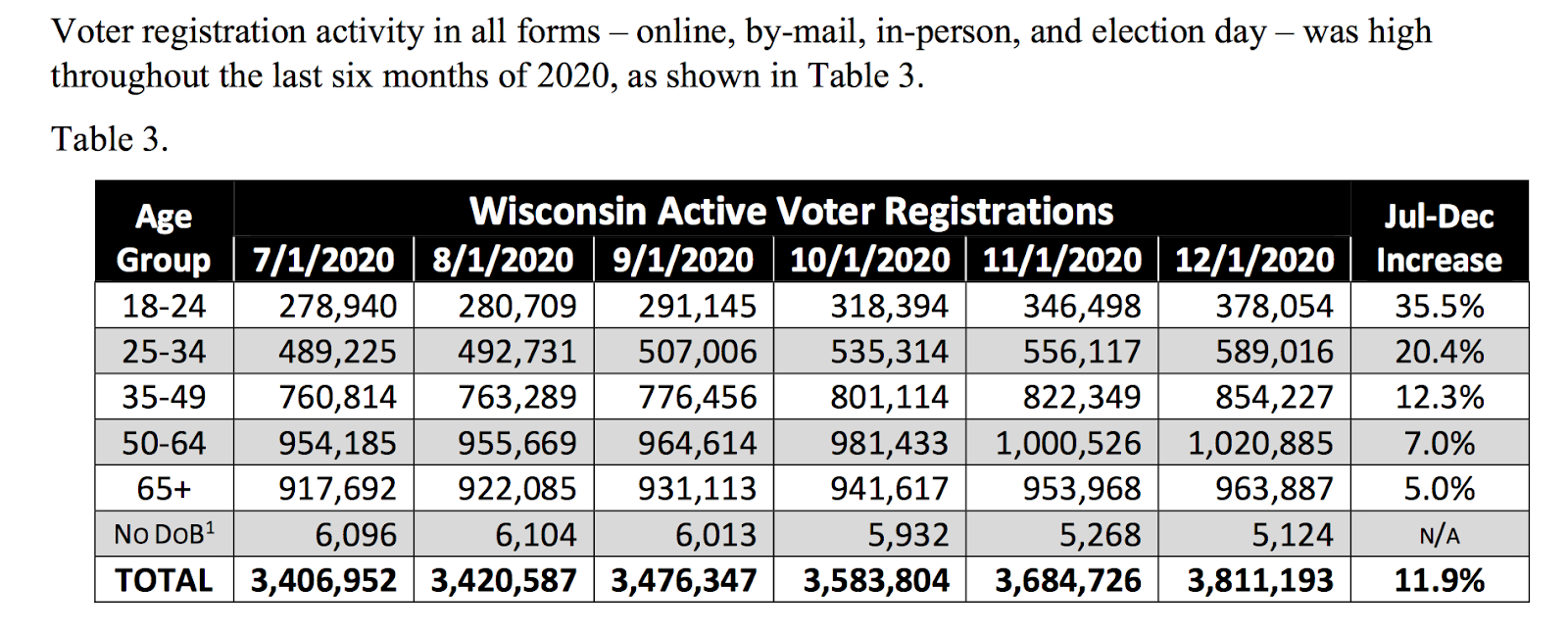Fact Checking More Claims About the 2020 Election in Wisconsin

In a viral Facebook video, Ivory Hecker—a former Fox 26 Houston reporter—has made a number of false claims about the Wisconsin 2020 presidential election.
In the video, which has garnered almost 80,000 views on Facebook, Hecker claims “Wisconsin had an active voter turnout of 93.7 percent” in 2020, whereas “normally” turnout is “up to 60 percent.”
But researchers say Hecker is making apples-to-orange comparisons with voter turnout data by failing to distinguish between active voter turnout and overall voter turnout.
In an email to The Dispatch Fact Check Hecker noted that the viral Facebook video is a teaser for her “full coverage” on YouTube. The video’s details come from “the IT expert who testified before the Wisconsin state legislature on 12/8/21.” Hecker explained that during that hearing “the IT expert explains 93.7% of ACTIVE voters cast ballots.” She added: “Also in the testimony he explains that if you do the math by including all Wisconsinites of voting age including those who aren’t registered, you can get the turnout number of 72%.”
(For further context, a presentation from that December 8 hearing can be seen here.)
In an email to The Dispatch Fact Check, Barry Burden, political science professor and the director of Elections Research Center at the University of Wisconsin-Madison, said that the 93.7 percent calculation is based on registration data from August. “That is misleading because many people register in the weeks just before the election,” he said. “Wisconsin even allows people to register at the polls on Election Day.”
Burden noted that according to data from the Wisconsin Elections Commission from February 2021, “the number of active registrants grew from about 3.4 million in August to around 3.8 million once all of the new registrant information was added.”

“Hecker is comparing apples and oranges by using turnout from Election Day but registration data from several months before Election Day,” said Burden. “Claiming that turnout using this method is usually no more than 60 percent is dead wrong and misleading.”
The voter turnout in 2020, using the voter age population as the denominator, was actually 72 percent, not 93.7 percent.
Here’s how we calculated that number.
According to data from the Milwaukee Journal Sentinel indicates that more than 3.2 million votes were cast in Wisconsin. The Wisconsin estimated voting age population, according to the Wisconsin Elections Commission, is 4,536,293. Given those two numbers, (dividing votes cast by the voting age population), the voter turnout comes out to be around 72 percent.
We’ve previously fact-checked a similar claim about Wisconsin’s voter turnout and highlighted a tweet thread from Craig Gilbert, the longtime Washington bureau chief for the Milwaukee Journal Sentinel, who explained that Wisconsin’s voter turnout was indeed “high” but not a record, and certainly not suspiciously so. Gilbert points out that Wisconsin voter turnout in 2008 was 69.2 percent, was 70.1 percent in 2012, and was 67.3 percent in 2016.
A spokesman for the Wisconsin Elections Commission confirmed the 2016 voter turnout, noting in an email to The Dispatch Fact Check that: “In 2016, there were about 2,996,886 total voters who participated, which represents roughly 67 percent of Wisconsin’s estimated voting age population of 4,461,068 at that time.”
In her Facebook video, Hecker continues by claiming that the “Wisconsin voter database padded voter registration numbers with precursor zero zero zero zeros, which allows for manipulating voter registration.” A spokesman from the Wisconsin Elections Commission told The Dispatch Fact Check via email that: “Registration numbers may begin with any character, including zeros. In the case of voter registration numbers, the computer ‘reads’ each number or character equally.”
The Wisconsin Elections Commission also addressed the claim noted on its website that Wisconsin does not have “duplicate voter registration numbers.”
Here’s the full explanation according to the Wisconsin Elections Commission:
“Wisconsin voter registration numbers consist of at least 9 characters and are alpha-numeric. This means they may include both numbers and letters. They may also begin with any character, including a zero. Thus, the registration number is really a special code and not merely a number.
“This small distinction sometimes causes confusion because people (and some common programs) often ignore leading zeros. For example, Microsoft Excel will automatically remove leading zeros from entries it identifies as numbers. If someone opens a CSV (Comma Separated Value) file in Excel without preserving leading zeros, Excel will erase them all. Thus, 000012345 becomes 12345. To preserve the digits, a user must access the original CSV file and import it to Excel using the “Get Data” tool. Or use dedicated database software such as Access to open the file.”
In the viral video Hecker also claims that “there are 120,000 people in Wisconsin who are more than a hundred years old and they’re voters.”
The Wisconsin Elections Commission addressed this claim too, by explaining why its voter registration database includes multiple voters with birth dates of 1/1/1900 and registration dates of 1/1/1918.
The full explanation: “Default dates of birth and voter registration dates in the WisVote database is not a newly discovered issue or an indication of voter fraud. This information has been in the State Voter Registration System (SVRS) and WisVote system since at least 2006 and is the result of data migration from over 200 different legacy voter registration systems maintained by individual municipalities that in 2005 were moved into the comprehensive statewide system.”
The Wisconsin Elections Commission further explained that: “as of fall 2021 there are still about 3,700 active voter records that contain default information for date of birth. In addition, about 120,000 records exist in the system with a default date of voter registration. Voters in either of those groups are not affected in any way by the default dates shown in their registration record. It’s important to note that a legally registered voter who has not changed any information which requires them to re-register stays registered regardless of whether the clerk has asked for an update or not.”
In response to a request for comment on the Wisconsin Elections Commission’s above explanation, Hecker responded: “I understand WEC is saying that 15 years ago they restructured and this is a supposed glitch in their system. It is indeed an anomaly that the election investigator pointed out in last month’s hearing. I have the authority under the first amendment to report that fact, and I will sue anyone who defames me for covering this.”
(We could not find where the State Elections Board, the agency responsible for administering election laws in Wisconsin in 2006, addressed this matter publicly.)
Lastly, Hecker claims that “Wisconsin has 4.5 million residents over the age of 18. The Wisconsin Elections Commission has more than 7 million voters on the roll.” Again, this is incorrect. It is true, as we mentioned, that Wisconsin has 4.5 million eligible voters, but only 3,684,726 registered voters in the state, per the Wisconsin Elections Commission, and just over 3.2 million votes were cast in Wisconsin.
Burden explained that Hecker’s 7 million figure appears to come from “adding together the active and inactive registrants.” According to the Wisconsin Elections Commission there are about 3.6 million inactive voters and 3.5 million active registered voters. Burden noted that: “Inactive registrants are still listed in the statewide voter database so that the state has a record of them, but they are not eligible to vote, having been deactivated because they moved, died, failed to vote over a series of elections and did not respond to mailings, or other reasons.”
If you have a claim you would like to see us fact check, please send us an email at factcheck@thedispatch.com. If you would like to suggest a correction to this piece or any other Dispatch article, please email corrections@thedispatch.com.